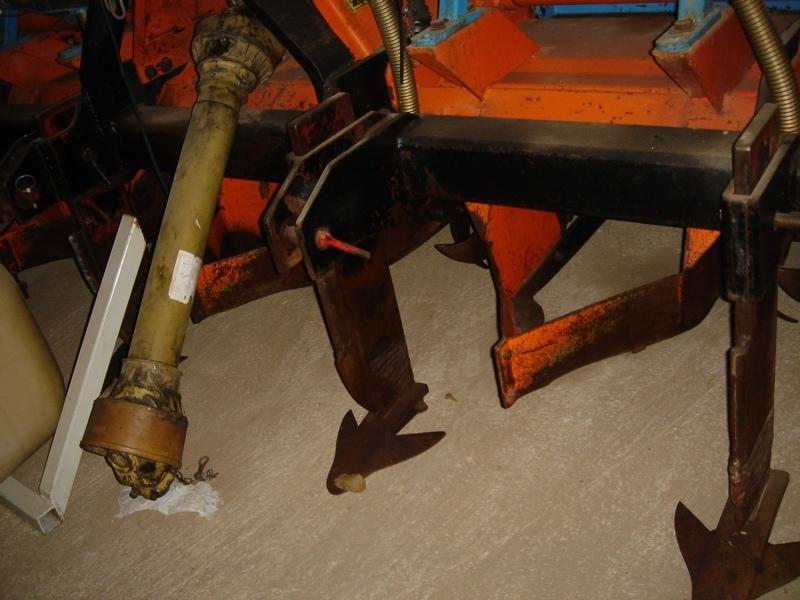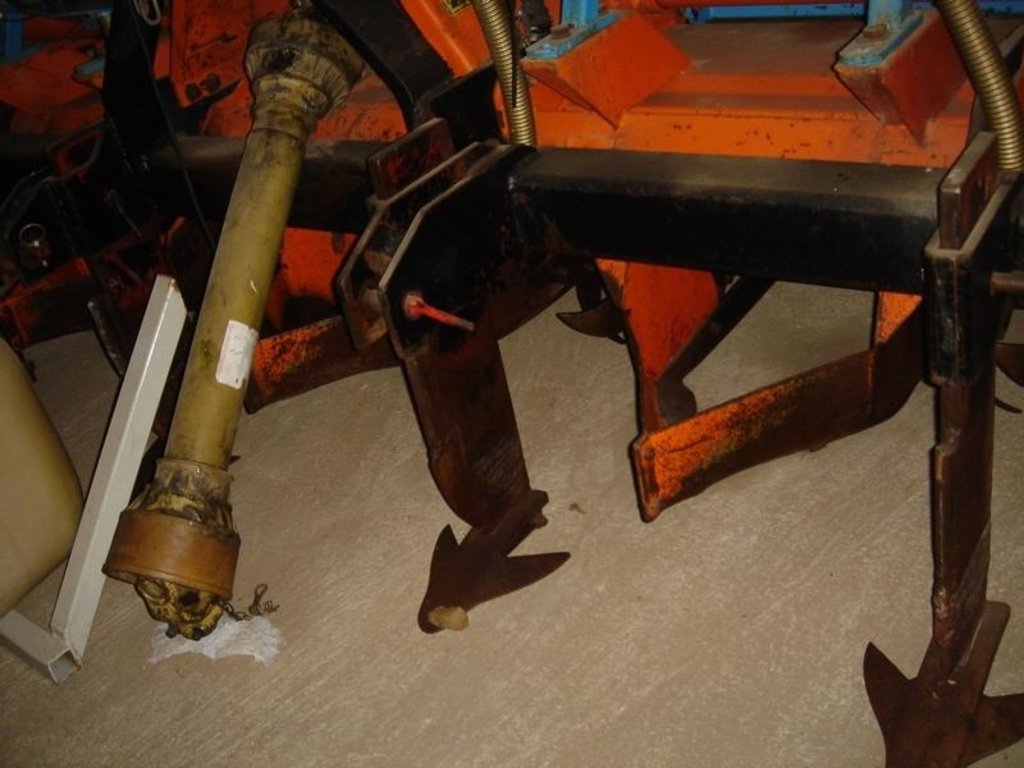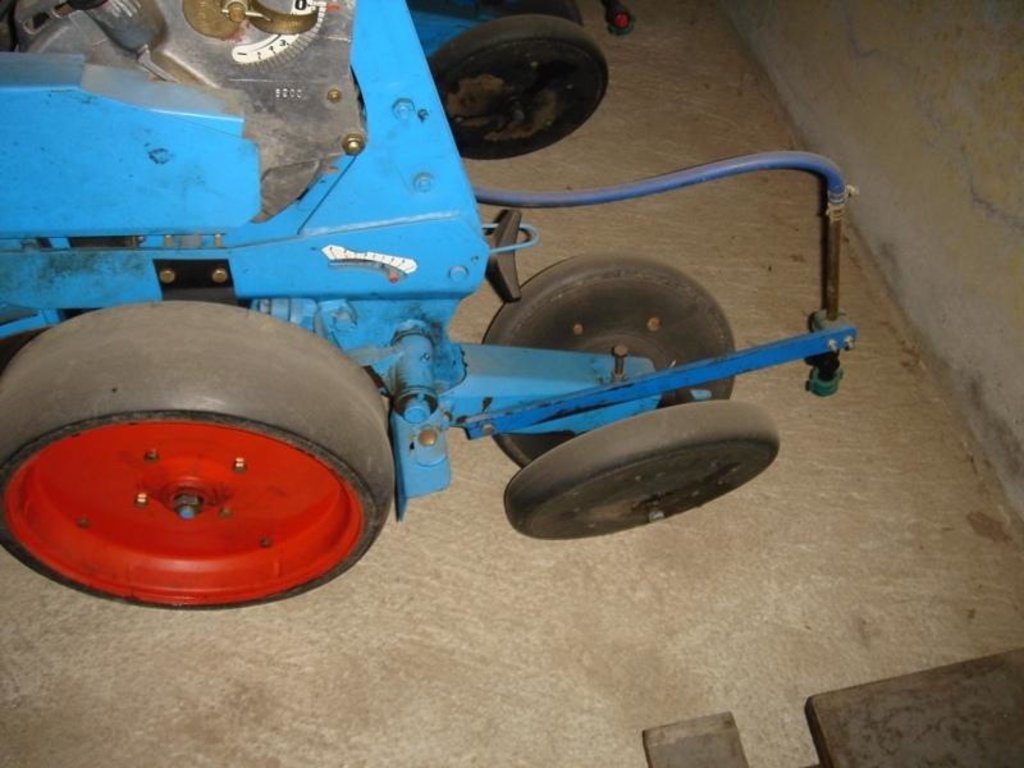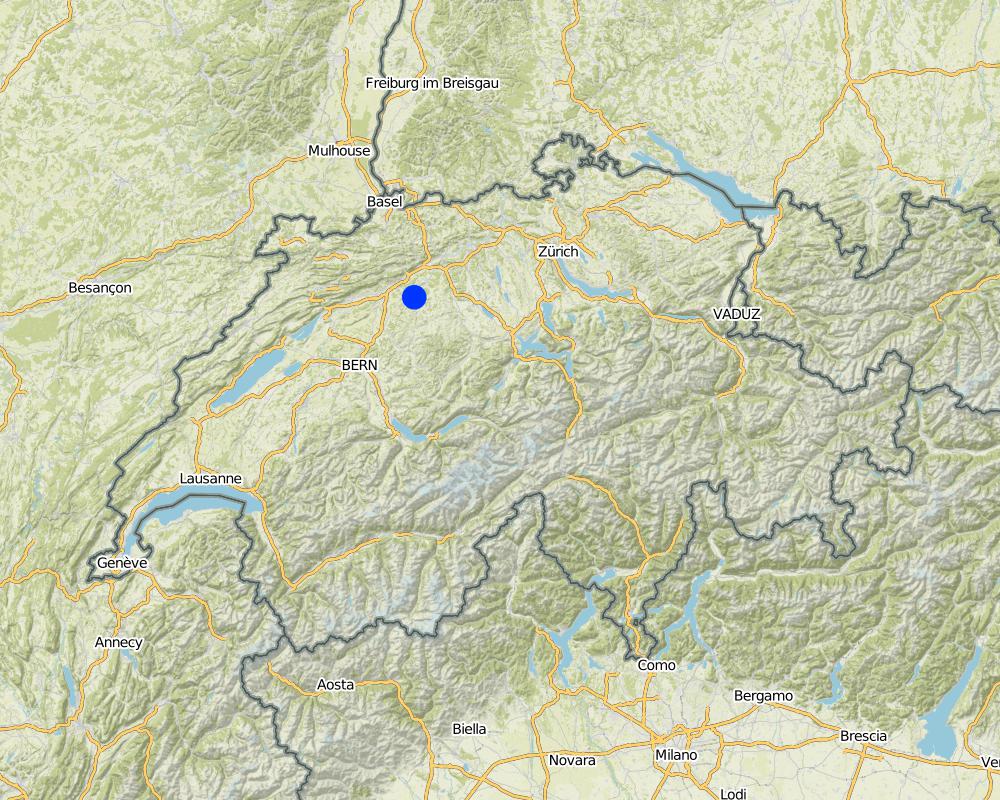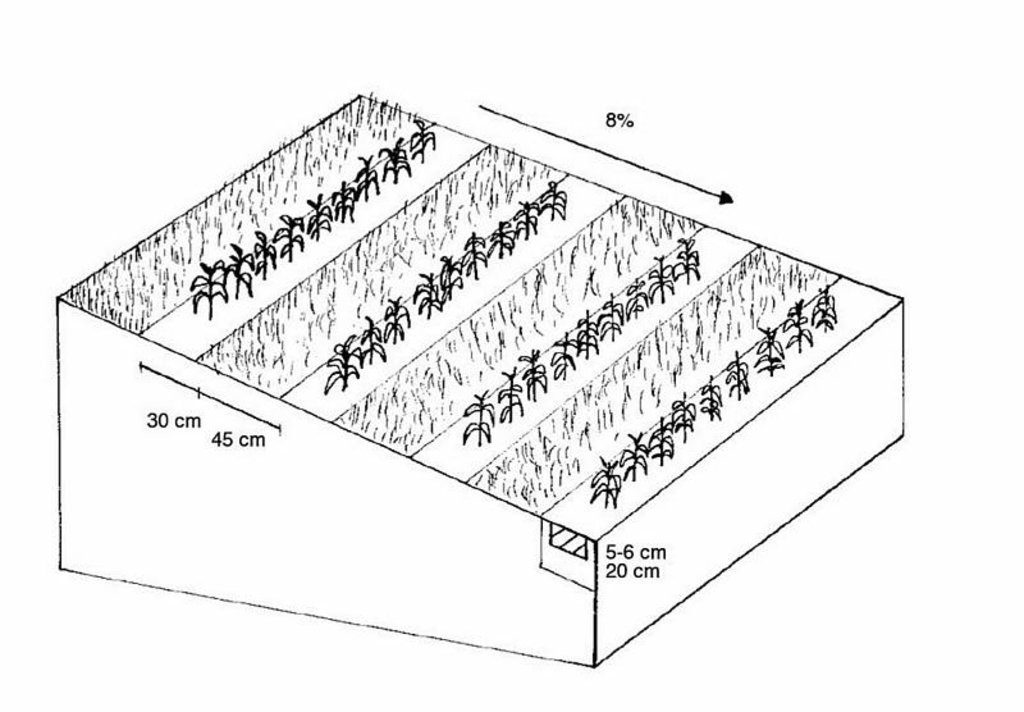Maize strip tillage [Suisse]
- Création :
- Mise à jour :
- Compilateur : Unknown User
- Rédacteur : –
- Examinateurs : Fabian Ottiger, Alexandra Gavilano
Streifenfrässaat
technologies_1010 - Suisse
Voir les sections
Développer tout Réduire tout1. Informations générales
1.3 Conditions relatives à l'utilisation par WOCAT des données documentées
Le compilateur et la(les) personne(s) ressource(s) acceptent les conditions relatives à l'utilisation par WOCAT des données documentées:
Oui
2. Description de la Technologie de GDT
2.1 Courte description de la Technologie
Définition de la Technologie:
Maize strip tillage is a conservating method for corn production.
2.2 Description détaillée de la Technologie
Description:
Maize strip tillage is a soil-conserving method used in crop production. First of all the grass in the area needs to be prepared by splattering round-up about 3-10 days prior to sowing.
If the weather conditions are dry enough, a special grubber ('Flügelschargrupper') slacks the soil (20cm), the fertilizer is added in the stripes and afterwards the seed is added. Then the actual maize strip tillage machine carves a stripe and the seed are inserted within this strip of 30 cm. At the same time fertilizer is added on these cultivated stripes. Between those cultivated stripes the mulch-grass stripes (45cm) are unmechanised and protect the soil by increasing its stability. At the end a herbicide is applied on the cultivated strip. All working steps can be done at the same time compared to the traditional technique whereas the farmer needs to drive for each working step separately.
There are some clear economic advantages using this technology. It is less time consuming and the costs for diesel are also lower. On the other hand, by applying maize strip tillage the timing of the cultivation is very important and if the conditions are too wet, it is very likely that a farmer needs more herbicide in order to guarantee an optimal growth period.
However, like in a minimum tillage system there are some ecological advantages like enhancing soil stability. Another advantage is the better soil structure due to the mulch stripes. Due to these mulch-stripes the matrix of the soil is more complex and therefore the stability is better especially during the harvest in September. Soil compaction would occur less and the possibility of soil erosion is decreasing. Especially in hilly areas, as there are many in Switzerland, the technology is suitable since soil erosion is a problem in hilly areas when using a plough.
The interviewed farmer said that the farmers need a sound knowledge about the natural environment. Compared to the traditional technology, the farmers need to observe the corn plants carefully in order to ensure their growth period. Frthermore he said that the farmers need to get used to the sensitivity of this technology. If they are not applying the right amount of herbicide, the probability of getting a smaller harvest is increasing. If springtime is humid, the farmers should be able to use the traditional technology cause this SLM technology is only useful if the conditions are not too humid.
The interviewed farmer said that the economic advantages would be very beneficial to most of the farmers. Although the establishment costs for the machines needed for this technology seem to be high. The farmer can also hire a contractor like him and then he only needs to pay the labour but not the equipment itself. If a farmer wants to apply this technology, the canton of Bern provides them with subsidies during the initial 5 years.
2.3 Photos de la Technologie
2.5 Pays/ région/ lieux où la Technologie a été appliquée et qui sont couverts par cette évaluation
Pays:
Suisse
Région/ Etat/ Province:
Bern
Autres spécifications du lieu:
Thunstetten
Spécifiez la diffusion de la Technologie:
- répartie uniformément sur une zone
S'il n'existe pas d'informations exactes sur la superficie, indiquez les limites approximatives de la zone couverte:
- 10-100 km2
Commentaires:
The farmer owns 35 km2 but is applying the technology on 100 km2 in the surrounding area
Map
×2.6 Date de mise en œuvre de la Technologie
Si l'année précise est inconnue, indiquez la date approximative: :
- il y a entre 10-50 ans
2.7 Introduction de la Technologie
Spécifiez comment la Technologie a été introduite: :
- au cours d'expérimentations / de recherches
Commentaires (type de projet, etc.) :
A decade ago a farmer invented the machine for maize strip tillage and the departmenet for soil conservation promoted this technology afterwards.
3. Classification de la Technologie de GDT
3.2 Type(s) actuel(s) d'utilisation des terres, là où la Technologie est appliquée

Terres cultivées
- Cultures annuelles
Cultures annuelles - Précisez les cultures:
- céréales - maïs
Nombre de période de croissance par an: :
- 1
Précisez:
Longest growing period in days: 150 Longest growing period from month to month: Apr - Sep
Commentaires:
Major land use problems (compiler’s opinion): If a plough is used when having a hillside situation the soil may easily erode.
Major land use problems (land users’ perception): The danger of erosion and soil compaction is accelareted when using a plough in a hillside area.
3.5 Groupe de GDT auquel appartient la Technologie
- perturbation minimale du sol
- mesures en travers de la pente
3.6 Mesures de GDT constituant la Technologie

pratiques agronomiques
- A3: Traitement de la couche superficielle du sol
A3: Différenciez les systèmes de travail du sol:
A 3.2: Reduced tillage (> 30% soil cover)
Commentaires:
Type of agronomic measures: better crop cover, retaining more vegetation cover, mulching, minimum tillage
3.7 Principaux types de dégradation des terres traités par la Technologie

érosion hydrique des sols
- Wt: perte de la couche superficielle des sols (couche arable)/ érosion de surface
- Wg: ravinement/ érosion en ravines

dégradation physique des sols
- Pc: compaction

dégradation biologique
- Bc: réduction de la couverture végétale
Commentaires:
Main type of degradation addressed: Wt: loss of topsoil / surface erosion
Secondary types of degradation addressed: Wg: gully erosion / gullying, Pc: compaction, Bc: reduction of vegetation cover
Main causes of degradation: crop management (annual, perennial, tree/shrub) (using the plough on hillside areas can increase soil erosion)
4. Spécifications techniques, activités, intrants et coûts de mise en œuvre
4.1 Dessin technique de la Technologie
Spécifications techniques (associées au dessin technique):
Technical knowledge required for field staff / advisors: high
Technical knowledge required for land users: moderate
Main technical functions: improvement of ground cover
Secondary technical functions: improvement of topsoil structure (compaction), increase in organic matter, increase of infiltration
Minimum tillage
Remarks: only where the crop seeds are inserted
4.2 Informations générales sur le calcul des intrants et des coûts
autre/ monnaie nationale (précisez):
Swiss Franc
Indiquez le taux de change des USD en devise locale, le cas échéant (p.ex. 1 USD = 79.9 réal brésilien): 1 USD = :
1,08
Indiquez le coût salarial moyen de la main d'œuvre par jour:
194.00
4.3 Activités de mise en place/ d'établissement
| Activité | Calendrier des activités (saisonnier) | |
|---|---|---|
| 1. | Buying machine for stripe mill cropping |
Commentaires:
Life span of the product: 15 years
4.4 Coûts et intrants nécessaires à la mise en place
Commentaires:
Duration of establishment phase: 2 month(s)
4.5 Activités d'entretien/ récurrentes
| Activité | Calendrier/ fréquence | |
|---|---|---|
| 1. | Applying Round-up herbicide on the area | 1 once before corn cultivation |
| 2. | Using of the machine for maize strip tillage, seeding and fertilizing within one workstep | 1 |
| 3. | Appliance for herbicide (Glyphosat) | 1-2 |
| 4. | Harvest of the corn | 1 |
4.6 Coûts et intrants nécessaires aux activités d'entretien/ récurrentes (par an)
Commentaires:
Establishment costs are estimated for the contractor. Labour costs indicated above are the costs which the contractor is demanding for if he is hired. Additionally, those farmers who adapt this technology can get subsidies from the Canton if the farmer commits to apply soil conservation measures during 5 years, in Bern it is 450 CHF per ha.
4.7 Facteurs les plus importants affectant les coûts
Décrivez les facteurs les plus importants affectant les coûts :
Labour costs might seem high for a farmer if he delegates the establishment to a contractor. In comparison to the traditional cultivation system the contractor would ask about $240 for ploughing , $185 for harrowing , $92 for seeding, $70 for biocide and $46 for fertilizer per ha. Therefore using maize strip tillage is almost a third less expensive than the traditional cultivation. Most of the farmers that hire the contractor are applying the biocides themselves when using maize strip tillage, which makes the costs even lower.
5. Environnement naturel et humain
5.1 Climat
Précipitations annuelles
- < 250 mm
- 251-500 mm
- 501-750 mm
- 751-1000 mm
- 1001-1500 mm
- 1501-2000 mm
- 2001-3000 mm
- 3001-4000 mm
- > 4000 mm
Spécifications/ commentaires sur les précipitations:
Average:
850-900 mm for the last 3 years
1200 mm some 10 years ago
Zone agro-climatique
- subhumide
Thermal climate class: temperate
5.2 Topographie
Pentes moyennes:
- plat (0-2 %)
- faible (3-5%)
- modéré (6-10%)
- onduleux (11-15%)
- vallonné (16-30%)
- raide (31-60%)
- très raide (>60%)
Reliefs:
- plateaux/ plaines
- crêtes
- flancs/ pentes de montagne
- flancs/ pentes de colline
- piémonts/ glacis (bas de pente)
- fonds de vallée/bas-fonds
Zones altitudinales:
- 0-100 m
- 101-500 m
- 501-1000 m
- 1001-1500 m
- 1501-2000 m
- 2001-2500 m
- 2501-3000 m
- 3001-4000 m
- > 4000 m
5.3 Sols
Profondeur moyenne du sol:
- très superficiel (0-20 cm)
- superficiel (21-50 cm)
- modérément profond (51-80 cm)
- profond (81-120 cm)
- très profond (>120 cm)
Texture du sol (de la couche arable):
- grossier/ léger (sablonneux)
- moyen (limoneux)
Matière organique de la couche arable:
- moyen (1-3%)
Si disponible, joignez une description complète du sol ou précisez les informations disponibles, par ex., type de sol, pH/ acidité du sol, capacité d'échange cationique, azote, salinité, etc.
Soil texture is coarse/light (sandy) or medium (loamy, silty) (medium till light soils, depending on the area. On heavy soils technology is not applied).
Soil fertility is medium
Soil drainage/infiltration is good
Soil water storage capacity is medium
5.4 Disponibilité et qualité de l'eau
Profondeur estimée de l’eau dans le sol:
5-50 m
Disponibilité de l’eau de surface:
bonne
Qualité de l’eau (non traitée):
eau potable
Commentaires et précisions supplémentaires sur la qualité et la quantité d'eau:
Ground water table: 5-50 m (depending on the area)
Water quality (untreted): Good drinking water (depending on the region)
5.6 Caractéristiques des exploitants des terres appliquant la Technologie
Revenus hors exploitation:
- 10-50% de tous les revenus
Niveau relatif de richesse:
- très riche
Individus ou groupes:
- individu/ ménage
Indiquez toute autre caractéristique pertinente des exploitants des terres:
Difference in the involvement of women and men: Usually the women are responsible for the administration and household and the men for the actual work on the fields, assuming that the decision to implement a new technology is made by both.
Population density: < 10 persons/km2
Annual population growth: < 0.5%
(His contract company is relatively large.).
5.8 Propriété foncière, droits d’utilisation des terres et de l'eau
Propriété foncière:
- individu, avec titre de propriété
Droits d’utilisation des terres:
- loué
Droits d’utilisation de l’eau:
- communautaire (organisé)
Commentaires:
The area around the farmer house is individually owned but the surrounding agricutlural land is leased.
5.9 Accès aux services et aux infrastructures
santé:
- pauvre
- modéré
- bonne
éducation:
- pauvre
- modéré
- bonne
assistance technique:
- pauvre
- modéré
- bonne
emploi (par ex. hors exploitation):
- pauvre
- modéré
- bonne
marchés:
- pauvre
- modéré
- bonne
énergie:
- pauvre
- modéré
- bonne
routes et transports:
- pauvre
- modéré
- bonne
eau potable et assainissement:
- pauvre
- modéré
- bonne
6. Impacts et conclusions
6.3 Exposition et sensibilité de la Technologie aux changements progressifs et aux évènements extrêmes/catastrophes liés au climat (telles que perçues par les exploitants des terres)
Changements climatiques progressifs
Changements climatiques progressifs
| Saison | Augmentation ou diminution | Comment la Technologie fait-elle face à cela? | |
|---|---|---|---|
| températures annuelles | augmente | bien |
Extrêmes climatiques (catastrophes)
Catastrophes météorologiques
| Comment la Technologie fait-elle face à cela? | |
|---|---|
| pluie torrentielle locale | bien |
| tempête de vent locale | pas connu |
Catastrophes climatiques
| Comment la Technologie fait-elle face à cela? | |
|---|---|
| sécheresse | bien |
Catastrophes hydrologiques
| Comment la Technologie fait-elle face à cela? | |
|---|---|
| inondation générale (rivière) | pas connu |
Autres conséquences liées au climat
Autres conséquences liées au climat
| Comment la Technologie fait-elle face à cela? | |
|---|---|
| réduction de la période de croissance | pas bien |
Commentaires:
With the grass stripes between the corn, the water can infiltrate faster and the soil is more stable and protected. The technology can be more tolerant towards intensive rainfalls but only to a certain moment. The technology is more sensitive towards humid conditions in spring and problems can accure when trying to apply the stripe mill cropping.
6.4 Analyse coûts-bénéfices
Quels sont les bénéfices comparativement aux coûts de mise en place (du point de vue des exploitants des terres)?
Rentabilité à court terme:
négative
Rentabilité à long terme:
positive
Quels sont les bénéfices comparativement aux coûts d'entretien récurrents (du point de vue des exploitants des terres)?
Rentabilité à court terme:
légèrement négative
Rentabilité à long terme:
positive
6.5 Adoption de la Technologie
Commentaires:
35% of land user families have adopted the Technology with external material support
Comments on acceptance with external material support: If farmers have good experiences more than 80% are maintaining this technology even without external subsidies of the Canton.
There is a moderate trend towards spontaneous adoption of the Technology
Comments on adoption trend: The subsidies from the Canton are very supportive for farmers to implement the new technology
7. Références et liens
7.1 Méthodes/ sources d'information
Liens et modules
Développer tout Réduire toutLiens
Aucun lien
Modules
Aucun module trouvé


